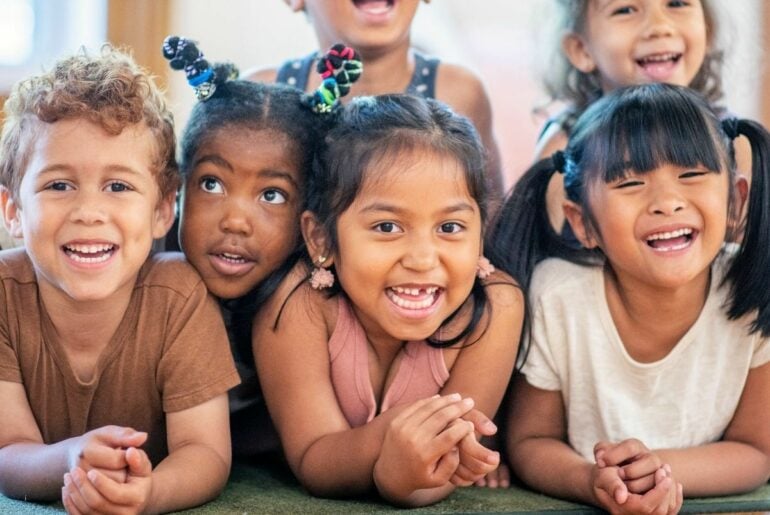According to the U.S. Census Bureau, the number of people who identify as multiracial has doubled in the past decade. In fact, “multiracial” is the fastest-growing category of Americans, growing three times faster than the population as a whole. So, even if your own family doesn’t have a lot of racial diversity in its background, your kids are sure to have multiracial friends and classmates. Kids recognize racial differences by six months old and begin to develop racial biases by preschool, so it’s up to parents to provide the context that lets kids know that all this diversity is a great thing!
In the Pew Research Center’s comprehensive report, Multiracial in America, a majority of multiracial adults surveyed stated they are proud of their heritage. However, 55 percent admitted to being subjected to racial slurs or insensitive jokes. Perhaps that’s why so many multiracial children are reluctant to respond to questions like, “What are you?” or “Where are you from?”—aside, of course, from the fact that the answer is often, “I’m an American, from right here in this town—just like you.”
Children want to fit in
A child’s need to fit in is instinctive. It gives them a sense of safety and security. But it can be challenging for multiracial kids since assumptions are often made based solely on looks. Single race peers and adults often express surprise that multiracial kids enjoy the same activities, foods, TV shows, games, and books. This can be confusing and hurtful. Well-meaning people who point out differences in complexion or hair texture in the guise of complimenting a child may actually be humiliating them. Even seemingly benign questions about where a child is “from” only serve to point out their “other-ness,” which can understandably make kids feel like outsiders.
It can be difficult to balance kids’ developmentally appropriate need to fit in with peers, with the equally important need to acknowledge and celebrate their differences. Here are five tips to empower multiracial children to accept their full intersectional identities and feel secure in who they are, and to help single-race kids accept and embrace their diversity, too.
1. Embrace uniqueness
Much as they want to be seen as the same, all kids are different. Talk about what’s unique about each member of your child’s friend group and celebrate their personal attributes. Tell your own story about the journey you’ve taken to accept your own individuality.
2. Understand stereotyping and how to respond
Science tells us that the earlier we talk to children about race and stereotyping the better, and experts caution that avoiding the subject can imply that racial differences are bad or “wrong” in some way. But parents typically report they’re not comfortable discussing it with kids until age 5, which is years after racial biases start to develop.
- Ask your children what they’ve heard, and help them to dispel any myths.
- Explain what stereotypes are—widely held but overly simplified images or beliefs about a person or group based on a characteristic they might share. Stereotypes are damaging because they erase the unique characteristics of individuals in the group. Emphasize that it’s okay to notice and talk about differences, but we shouldn’t make assumptions about people we don’t know.
- Since kids are influenced by their parents’ prejudices, inventory your own words and deeds that imply discrimination. Start with these five questions.
- Avoid the self-sabotage of negative talk around your own heritage.
- Make the conversation about race ongoing and long term in your family.
3. Find opportunities to celebrate all aspects of who they are
Explore the family through an Ancestry search. Create an oral history by interviewing grandparents, aunts, and uncles. Celebrate holidays and special occasions common to your family heritage. Incorporate traditions in everyday life from decorating their room to learning a handicraft. Visit historical locations and cultural centers. Study the language. Learn about heros and important historical figures with a racial background similar to your child’s.
4. Provide tools to connect with different people
Teaching kids to love themselves—and teaching about tolerance more widely—helps them adapt, socialize, and thrive in the diverse world we live in. Learning to connect with people who are different from them, while still honoring their own racial and ethnic identity, is a skill you can help your child strengthen at home in a number of ways.
- Ensure your child has plenty of access to media like games, books, shows and movies that include representation of their own heritage. Giving them examples of people who look like them doing everyday things and experiencing a whole range of human experience can help them build pride in their background, while showing them that they have a lot in common with people who might not look like them, too.
- Use some of those cultural crafts, foods, and culturally significant locations to enrich playdates with your child and their young friends. Your child may enjoy sharing their expertise in how to use chopsticks or showing a friend around a nearby cultural center.
- Give them the language to use when people ask uncomfortable questions about their race. If someone asks, “What are you?” they might respond, “I’m a human!” or “I’m American, just like you,” or you might give them a more straightforward answer, like, “I’m Latino-Asian.” Try to avoid using fractions, like half Black and half Indigenous, to describe their heritage, since that can make kids feel divided and unsure about their identity.
5. Support their chosen identity
According to the Pew Research Center, “Multiracial identity is complicated, as much an attitude that can change over a lifetime as it is a genetic or biological certainty.” As a multiracial child has more opportunities to explore who they are, they may decide to identify more strongly with one race or ethnicity than the other—or to not make any choice at all. It can be really troubling to be asked, “What are you?” so if they choose to not respond or to answer in a way you may not have chosen, validate and respect that choice.
At any given time, they may identify more with a racial identity that they feel matches more closely with their physical appearance, or with the cultural practices they were raised with at home. Just like all of us, who they are today may not be who they are tomorrow. Accepting them as the wonderful individual they are right now is far more important than any label.
What can single-race kids and families do?
Part of supporting multicultural kids—and raising the next generation of empathetic human beings—means teaching all kids to be tolerant, accepting, and compassionate.
- Talk about the reasons why questions like “Where are you from” or “What are you” can be hurtful and damaging.
- Include a variety of perspectives in your media. Be sure the movies, TV shows, and books available to your kids include representation of cultures and races they might be less familiar with. If your kids are young, be sure to provide art supplies in a range of skin tones so their drawings aren’t limited to a few narrow choices.
- Introduce different languages and foods. Whether you’re exploring your own cultural favorites or learning about other ethnic traditions, include language through music, counting in other languages, or visiting areas of your city where other languages are spoken. Experimenting with recipes is another way to help kids gain an understanding and appreciation of diverse cultures.
- Compliment kindness and empathy whenever you see or hear about your child being kind to a neighbor, standing up for someone being bullied for being different, or making an effort to understand someone else’s point of view. They’ll learn that empathy toward others is an important family value, and carry that into all their interactions through adulthood.






